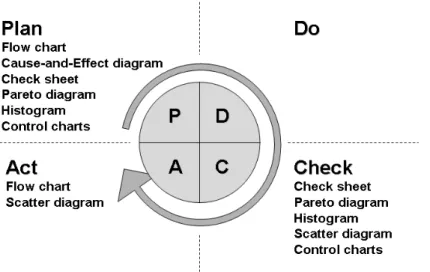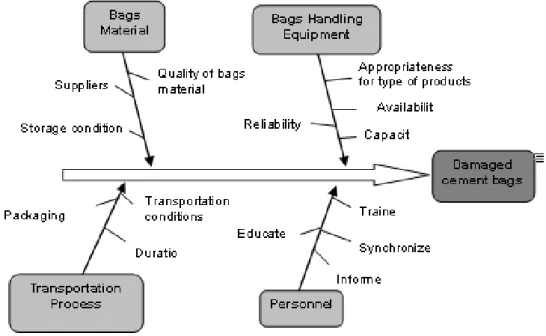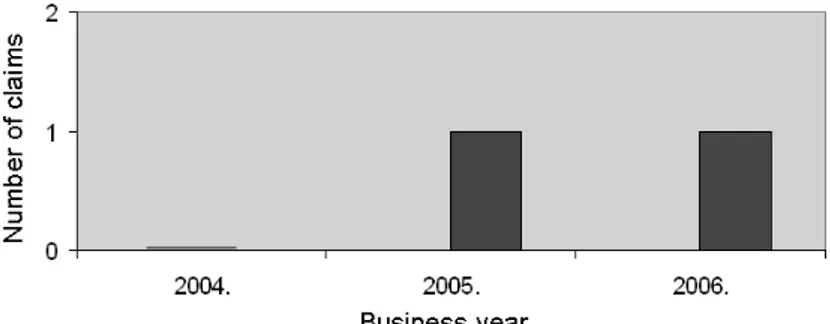International Journal for Quality research UDK- 658.562
Short Scientific Paper (1.03)
Duško Pavleti
ć
1)Mirko Sokovi
ć
2)Glorija Paliska
3)Faculty of Engineering
Rijeka
1)Faculty of Mechanical
Engineering Ljubljana,
Slovenia
2)Holcim (Hrvatska) d.o.o.,
Koromacno, Croatia
3)Practical Application of Quality Tools
Abstract:
The paper is dealing with one segment of broader
research of universality an systematicness in application of
seven basic quality tools (7QC tools), which is possible to
use in different areas: power plant, process industry,
government, health and tourism services. The aim of the
paper was to show on practical examples that there is real
possibility of application of 7QC tools. Furthermore, the
research has to show to what extent are selected tools in
usage and what reasons of avoiding their broader
application are. The simple example of successful
application
of
the quality tools are shown on selected
company in process industry.
Keywords:
Quality Management, Quality Tools,
Histogram, Ishikawa diagram
1. INTRODUCTION
Continuous quality improvement process assumes, and even demands that team of experts in field as well as company leadership actively use quality tools in their improvement activities and decision making process. Quality tools can be used in all phases of production process, from the beginning of product development up to product marketing and customer support. At the moment there are a significant number of quality assurance and quality management tools on disposal to quality experts and managers, so the selection of most appropriated one is not always an easy task. In the conducted research it is investigated possibilities of successful application of 7QC tools in several companies in power generating and process industry as well as government, tourism and health services. The seven analysed quality tools are:
o Flow chart
o Cause-and-Effect diagram o Check sheet
o Pareto diagram o Histogram o Scatter plot o Control charts
Furthermore, as a part of the research is analysis of possibilities of systematic use of
quality tools in process industry, what is show in this paper on simple example.
2. QUALITY MANAGEMENT SYSTEM
In successful application of quality tools the implemented quality management system is advantage. The quality management principles are starting point for company’s management striving for continuous efficiency improvement in long period of time and customer satisfaction [1-4]. Quality management system is based on integrity of all production and support resources of certain company. It enables faultless process flow in meeting related contracts, standards and market quality requirements. Implementation of quality management system is always a part of a company development process, Fig. 1 [5]
company has to select the most efficient ways of data acquisition and market survey to confirm does the company’s products or services meets customer demands and expectations. Collected information is invaluable in decision making process based on fact. Data collection and analysis is also of great importance for defining opportunities for further process and products quality
improvement.
Continuous improvement process is based on application of Deming’s quality cycle or cycle, shown on Fig. 2. The PDCA-cycle is integral part of process management and is designed to be used as dynamic model. The completion of one turn of cycle flows into the beginning of the next
Figure 1 - Development of quality management concept
Figure 2 - PDCA-cycle
Main purpose of PDCA-cycle application is in process improvement. When the process improvement starts with careful planning it results in corrective and preventive actions, supported by appropriate quality assurance tools, which leads to true process improvement. Application of seven basic quality tools in correlation with four steps of PDCA-cycle is shown in Table 1.
As it is shown in Table 1, for problem identification can be used most of the 7QC tools: Flow chart, Cause-and-Effect diagram, Check sheet, Pareto diagram, Histogram and Control charts. For problem analysis are used following tools: Cause-and-Effect diagram, Check sheet,
Pareto diagram, Scatter plot and Control charts. When the team is developing a solution for analyzed problem Flow chart and Scatter plot can be useful. In the phase of achieved results evaluation can be also most of 7QC tools successfully implemented: Check sheet, Pareto diagram, Histogram, Scatter plot and Control charts [7].
Table 1 - Seven basic quality tools (7QC tools) in correlation with PDCA-cycle steps
Steps of PDCA-cycle
Plan Do Plan, Check Plan, Act Check Seven basic
quality tools
(7QC tools) Problem identification
Implement solutions
Process analysis
Solutions development
Result evaluation
Flow chart 9 9
Cause-and-effect diagram
9 9
Check sheet 9 9 9
Pareto diagram 9 9 9
Histogram 9 9
Scatter plot 9 9 9
Control charts 9 9 9
Loop 1 emphasize analyses the biggest causes which is find with Pareto diagram and Loop 2 emphasize continuous improving process which is one of eight QMS principles. Implementation if this principle you make big stride which make possible translate of quality management system from static to dynamic status.
3. APPLICATION OF QUALITY
TOOLS IN PROCESS
INDUSTRY
Generally, business goal of every company is success in doing business. That success is shown through customer recognized quality of company’s products and services. However, defining quality is largely under subjective customer opinion and criteria. To become more objective in the quality evaluation introduction of standards for quality management is necessity. Quality management standard includes guidelines and recommendations for quality management system that encompass company organization structure, processes, procedures and other necessary means for successful quality management.
In the paper the systematic approach to the quality improvement is shown on the simple example of a company in process industry. The company defined the principle of quality management as basic principle with goals of continuous improvement. Customer satisfaction is placed on the top of value scale, while data analysis is conducted permanently in order to recognize opportunities for process quality improvement. Selected company from process industry has certified quality management system
in accordance with ISO 9000:2000.
Company that manage its quality system in accordance with ISO 9000:2000 has to plan and implement process control, measurement, analysis and improvement in order to:
o demonstrate conformity of its products, o achieve conformity of its quality
management system,
o continuously improve efficiency of its
quality management system.
Application of 7QC tools is analyzed in order to demonstrate possibility of systematic tools usage or, in other words, systematicness of quality tools.
Although, the research has investigated possibilities and usefulness of application of all of 7QC tools, in the paper are shown application of only one of quality tools - histogram. Example of systematic usage of quality tools is shown on procedure that includes communication with customer in process of dealing with customer claims. Immediately after a customer claim is received follows activities for removing causes of customer dissatisfaction that include corrective and preventive actions. The customer is, in written form, informed about all undertaken activities and appropriate claim report is prepared.
The number of customer claims is collected for three consecutive business years. On the end of each business year customer claims are systematically analyzed in order to identify type and amount of customer claims for year in consideration. Also, the undertaken corrective and preventive actions are analyzed to verify their effectiveness. One of broadly used tools to visualized collected data is histogram.
Figure 4 - Histogram of claims on damaged cement bag
Other 7QC tools are used in order to evaluate is there more opportunities to improve process and meet customer demands.
the number of damaged cement bags during transport in the last three business years, it can be concluded that number of damaged bags is in increase, Fig. 4. The next conclusion is that the past and current corrective activates taken within company wasn’t successful in solving problem.
So, further activities should be carried out, possible in the direction or in cooperation with company that provides transport of cement bags. Improvement team that include experts from company that produce cement and transport company can be formed with aim to find and eliminate root cause of damage cement bag problem.
Based on the Pareto diagram and Histogram, the improvement team has used the Cause-and-effect or Ishikawa diagram in order to
analyse and find out the root cause for cement bags damages, Fig. 5. The team is taking into account all potential sources of bags damage causes. By the eliminating one by one potential cause, the team will eventually come to the cause that has major contribution to bags damaging. Removing the root cause the process is improved, but the improvement activities are not completed until it is confirmed that the improvement is effective, loop 2 on the Fig. 3.
In the opposite of previous example, analyzing customer claims on wet cement bags for taken period of three year it can be seen that taken action results in significant reduction of customer claims, Fig. 6.
Figure 5 – Cause and effect diagram for root cause analysis of damaged cement bags problem
\
Such results haven’t come from a scratch. After several unsuccessful attempts to solve that problem in cooperation with transport company in a previous period, the solution is founded in house. The new machine for cement bags packaging that wrap cement bags with plastic foil has been installed at the beginning of year 2006. That solution has proven as successful and customer claims of
that type has been reduced to minimum. During 2006 there are no complains on wet cement bags.
Although some other indices show that the quality of products is acceptable the continuous improvement process is ongoing. So, for example, the number of customer claims on cement shipping and transportation in last tree business years is quite low, Fig. 7.
Figure 7 - Histogram of claims on cement shipping and transportation
Although there are small number of claims certain corrective actions has been taken to reduced it to minimum. Together with transport company corrective actions has been defined and conducted. Further analysis is needed to found root cause of this problem and to effectively solve it.
In the shown examples systematic use of histogram is demonstrated. Collected data are analyzed and visualized by histogram. Corrective actions are defined and implemented in order to remove root cause of problem. 7QC tools are used as base for process improvement and increase of customer satisfaction.
4. CONCLUSIONS
Research has been conducted in order to define role and importance of seven basic quality tools (7QC tools) within quality management system. It is shown that 7QC tools can be used in all process phases, from the beginning of a product development up to management of a process, on day to day basis, in systematic manner.
In modern production processes it is necessary to implement integrated quality management system that involves quality management, responsible environmental
performance and safe working environment. In the frame of integrated management system quality tools can be much wider applied with certain success. Furthermore, systematic application of 7QC tools will enable successful quality improvement process.
As it is shown in selected examples, quality tools has important place in data collecting, analyzing, visualizing and making sound base for data founded decision making.
Although the seven basic quality tools have been reach its maturity, and there are a great number of new quality tools that are on disposal for different purposes in a frame of quality management and quality engineering, the research have shown that the application of basic quality tools in industry and services are not so common. It is necessary to point out that quality tools are not so wide spread as expected, although they are quite simple for application and easy for interpretation. With today computer capabilities and automated data acquisition there should not be any technical obstacles for wider quality tools application. In spite, during research, it is experienced certain discomfort towards quality tools. This state should be changed through continuous staff education and training.
REFERENCES
[1]
Paliska G., Universality and Systematicness of Quality Tools, M.Sc. thesis, Supervisor
D. Pavletic, Faculty of Engineering, University of Rijeka, Croatia, 2007.
[2]
Paliska G., Pavletic D. and Sokovic M., Quality tools – systematic use in process
industry, Journal of Achievements in Materials and Manufacturing Engineering, Vol. 25
(2007), No. 1, pp. 79-82.
[3]
Kondic Z., Quality and ISO 9000
– Application, Tiva, Varazdin, Croatia, 2002 (in
Croatian).
[4]
N.N., Application of Quality Management System, Seminar, Austrian Association for
Quality Assurance, Zagreb, Croatia, 2003, (in Croatian).
[5]
N.N., TQM – Improvement of Business Processes, Oskar - Centar for Development and
Quality, Zagreb, Croatia, 2002, (in Croatian).
[6]
Injac N., Small Encyclopaedia of Quality, I-III parts, Oskar, Zagreb, Croatia, 2002, (in
Croatian),
[7]
Pimblott J.G., Managing Improvement – Where to Start, Quality Forum, Vol. 16 (1990),
No. 4, pp. 165-173.
[8]
Sokovic M., Jovanovic J., Krivokapic Z. and Vujovic A., Quality tools in improvement
process, Proceedings of the 2
ndInt. Conf. ICQME 2007, Milocer, Montenegro, pp.
21-28.
[9]




